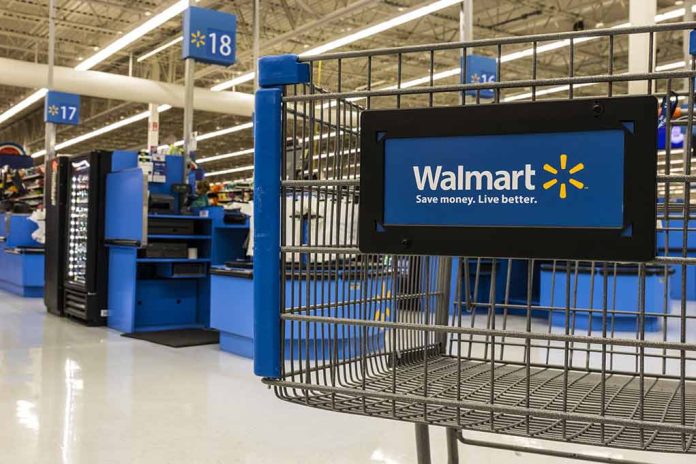
Walmart’s CEO shocks Wall Street by revealing how the retail giant plans to not just survive but thrive under President Trump’s new tariffs, potentially leaving competitors scrambling to keep up.
Key Takeaways
- Walmart CEO Doug McMillon plans to “play offense” during the tariff implementation, seeing an opportunity to increase market share while competitors struggle.
- Two-thirds of Walmart’s products are made in the US and therefore not subject to tariffs, giving them a competitive advantage.
- Walmart has historically gained market share during economic downturns, including during the pandemic and Great Financial Crisis.
- The retailer’s Walmart+ membership program, with an estimated 25 million members, has become a strategic asset with subscribers spending nearly three times more than non-members.
- Walmart warned that certain imported goods, particularly electronics, clothes, and toys, will likely see price increases despite their efforts.
Walmart’s Bold Strategy Amid Tariff Challenges
While most retailers are bracing for impact from President Trump’s implementation of significant tariffs on imported goods, Walmart is taking a remarkably different approach. During a recent investor day presentation, CEO Doug McMillon stunned Wall Street by suggesting Walmart is positioned to “play offense” rather than simply weather the storm. This aggressive stance comes as Trump’s administration implements a 120% + duty on Chinese imports and a 46% levy on goods from Vietnam, measures designed to strengthen American manufacturing and reduce dependence on foreign production.
The retail giant’s confidence stems partly from its supply chain composition – CFO John David Rainey revealed that approximately two-thirds of Walmart’s products are manufactured in the United States, significantly reducing their exposure to international tariffs compared to competitors. This domestic sourcing advantage gives Walmart substantial leverage in maintaining price competitiveness while other retailers may be forced to implement steeper price increases to maintain profit margins.
Historical Resilience in Economic Downturns
Walmart’s leadership wasn’t merely posturing when they expressed confidence in their ability to navigate tariff challenges. The company has a proven track record of not just surviving but thriving during periods of economic turbulence. During both the Great Financial Crisis and the pandemic, Walmart significantly expanded its market share as price-conscious consumers sought more affordable shopping options. The retail giant’s scale allows it to negotiate more effectively with suppliers and absorb some cost increases that would cripple smaller competitors.
“While tariffs were expected, the scale and scope of them has come as a shock,” said Neil Saunders, Managing Director of GlobalData Retail. “The immediate impact will be some short-term disruption and an increase in costs that will need to be managed.”
Despite issuing rare guidance that it could not predict future profits due to tariff uncertainties – an unusual move for a company of Walmart’s size – executives maintain their fundamental business model positions them well to capitalize on changing market conditions. The company’s priorities remain unchanged: keeping prices lower than competitors, managing inventory effectively, and controlling expenses amid market volatility.
Walmart+ Membership: A Strategic Asset
Beyond supply chain advantages, Walmart has quietly been developing another powerful weapon against economic headwinds: its membership program. Walmart+ has grown to an estimated 25 million members as of early 2025, more than doubling since fall 2022. These members account for nearly 50% of spending on Walmart’s website and app, proving the program’s effectiveness as a “frequency driver” for customer engagement and loyalty.
“With the consumer driving 70 percent of the U.S. economy, Walmart’s weak guidance gave rise to some nervousness [about] potential consumer spending going forward,” explained Robert Pavlik, senior portfolio manager at Dakota Wealth Management, highlighting why Walmart’s strategic positioning is being closely watched as an economic bellwether.
The statistics are compelling – Walmart+ members shop twice as frequently and spend nearly three times as much as non-subscribers. The program offers perks including free shipping, same-day grocery deliveries, gas discounts, and a Paramount+ subscription. Additionally, the company recently introduced Walmart+ Assist, which offers discounted membership to customers qualifying for government assistance, further expanding their potential market reach during challenging economic times.
Price Impact Unavoidable Despite Best Efforts
Despite Walmart’s advantageous positioning, the company has acknowledged that some price increases are inevitable. Industry analysts expect electronics, clothing, and toys – categories heavily dependent on imports – to see the most significant price hikes. However, Walmart’s scale and purchasing power should allow it to minimize these increases compared to competitors, potentially attracting even more price-sensitive consumers to their stores.
The company’s forecast includes expected net sales growth of 3% to 4% and adjusted operating income increases of 3.5% to 5.5%, demonstrating confidence in their ability to maintain growth despite market challenges. With eleven consecutive quarters of double-digit online sales growth in the United States already on the books, Walmart appears well-positioned to continue its expansion of market share as economic conditions evolve under President Trump’s trade policies.






















